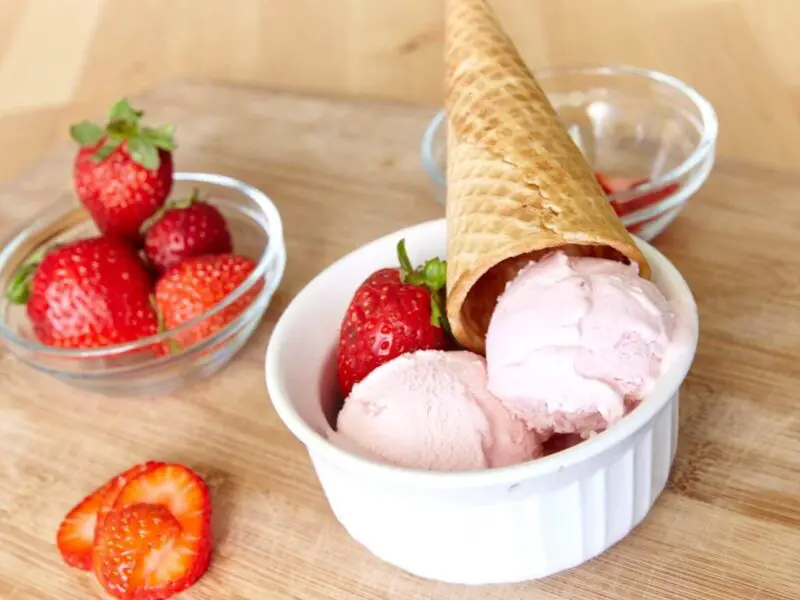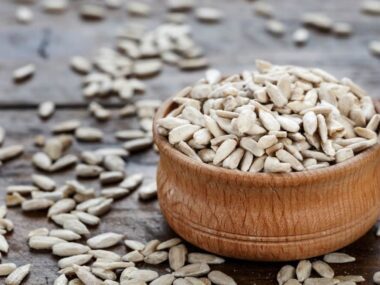As someone with a major sweet tooth who also tries to keep my sugar intake in check, I’m always on the lookout for healthier sugar substitutes for ice cream whenever I get a craving for dessert. Ice cream is one of my biggest weaknesses, but all that sugar can really pack on the calories if I’m not careful. Over the years I’ve experimented with quite a few sugar substitutes to find the best options for satisfying my ice cream cravings without totally derailing my diet. Here are my top picks for healthier sugar substitutes to use in homemade ice cream.
Best Sugar Substitutes for Ice Cream
Maple Syrup
One of my go-to substitutes is maple syrup. It has a delicious naturally sweet flavor that works great in ice cream, especially in autumn and winter flavors like pumpkin pie or gingerbread. The best part is that maple syrup is lower on the glycemic index than regular white table sugar, so it won’t spike your blood sugar as much. Start with 1/4 cup maple syrup in place of 1/2 cup sugar. You may need to add a bit more for sweeter flavors.
Honey
Another classic option is honey. Locally sourced raw honey has antioxidants and tastes wonderful in ice cream. I especially like using honey in ice creams with nuts, fruits, or toasted coconut for extra layers of flavor. Honey has a lower glycemic index than sugar too. Swap 1/4 cup honey for 1/2 cup sugar. The flavor is slightly more pronounced than maple syrup so you may not need quite as much.
Date Sugar
Made by grinding dried dates into a fine powder, date sugar is one of the best tasting and lowest glycemic substitutes. It has a rich caramel flavor that enhances pretty much any ice cream. For fruit flavored ice creams particularly, I find date sugar brings out the natural sweetness even more than regular sugar. Use 1 cup date sugar in place of 1 cup white sugar.
Stevia
If you’re looking for a no-calorie option, stevia is a great sugar substitute for sugar-free ice creams. It’s made from the leaves of the stevia plant and has zero calories and glycemic impact. Start with 1/4 teaspoon of powdered stevia or 2-3 drops of liquid stevia in place of 1/2 cup sugar. The flavor is very concentrated so go slowly until you get the sweetness level just right.
Coconut Sugar
With a low glycemic index and molasses-like flavor, coconut sugar is a tasty alternative. It caramelizes nicely too. Use 1 cup coconut sugar in place of 1 cup white sugar. Be aware it has slightly more calories than other substitutes at around 15 calories per tablespoon versus sugar’s 16 calories.
Monk Fruit Sweetener
Made from the super sweet monk fruit, this zero-calorie substitute has gained popularity in recent years. It has no aftertaste like some sugar alcohols. Use 1/4-1/2 cup powdered monk fruit sweetener to replace 1 cup sugar. It’s a bit pricey but worth it if you need something without calories.
Yacon Syrup
With prebiotic fiber and the incredible charm of being low glycemic and low calorie (15 calories per tablespoon), this chicory plant-based syrup has gained a health halo. It has natural vanilla and caramel notes that taste delicious in ice cream. Use 1/4 cup yacon syrup to replace 1/2 cup sugar.
Agave Nectar
With a mild honey-like sweetness, agave nectar is lower on the glycemic index than table sugar. It also adds creaminess to the texture. Use 1/4 cup agave nectar in place of 1/2 cup sugar.
Brown Rice Syrup
This mild-tasting syrup lends ice cream an enhanced butterscotch or toffee flavor. Use 1/3 cup brown rice syrup to swap for 1/2 cup white sugar. It has a consistency similar to honey or agave.
Banana Puree
For banana or tropical fruit flavored ice creams, mashing ripe banana into the base adds natural sweetness with far less added sugar. Start with 1/2 a very ripe banana blended until smooth per 1 cup of your recipe’s sugar.
Applesauce
Works similarly to banana for apple pie or orchard fruit ice creams. Use 1/2 cup pureed unsweetened applesauce in place of 1/2 cup sugar.
Mashed Fruit
Things like mashed berries, peaches or mangoes also pack in natural sweetness with less refined sugar. Start with 1/2 cup pureed fruit per 1 cup sugar and adjust to taste.
Those are my top picks for healthier sugar substitutes to use when making homemade ice cream. Experiment to see which ones you and your family prefer based on flavor, calorie goals, and diet preferences. With these natural options, you can satisfy your sweet tooth without spiking your blood sugar or overdoing it on calories. Enjoy every bite of your guilt-free frozen treat!
FAQs
Here are some FAQs on sugar substitutes for homemade ice cream:
What sweetener would you recommend for kids?
For picky kid palates, honey or maple syrup are usually popular choices since the taste is mellow and somewhat familiar. You could also try mashed banana or applesauce for natural sweetness without an unfamiliar taste. Start with 1/4 the amount of sugar called for in the recipe.
Are natural substitutes healthier than artificial sweeteners?
Most natural options like honey, maple syrup and fruit purees are preferable to artificial sweeteners for health since they contain small amounts of micronutrients along with natural fiber. Stevia and monk fruit sweetener are considered healthier artificial choices when calories need to be very low. But in moderation any can fit into a balanced diet.
How do you know which amount to substitute?
Start with the amounts suggested here as a guide – usually 1/4 to 1/3 cup natural sweetener in place of 1/2 cup sugar. Then taste as you go until the sweetness level tastes right to you. Adjust the amount up or down to your taste preferences. The flavor from substitutes can be more potent.
Can I substitute sweetener partway through the process?
It’s best to substitute the sweetener right from the start when creating a custard or ice cream base, as the sweetness may not distribute as evenly if added partway through. For no-churn ice creams you can likely substitute once the ingredients are combined.
Do any substitutes cause ice cream to melt faster?
Honey and maple syrup can impart slightly greater moisture into ice cream leading to meltdown more quickly on a hot day. For those options, be sure to thoroughly chill before serving. Otherwise, most substitutes behave similar to sugar texture-wise.
How do I know which substitute is lowest glycemic?
Maple syrup, honey, coconut sugar and monk fruit sweetener are the lowest impact options. Check packaging of processed substitutes for actual GI values. Whole fruits/veggies blended in will also lower the GI effect compared to isolated sugars.
Does the substitution change the nutrition info?
Yes, substituting will alter calorie, carb and sugar counts to varying degrees depending on the specific ingredient. Consult nutrition data online to compare amounts and adjust accordingly for your macros.
Can substitutes cause upset stomach?
Some like coconut sugar, stevia, yacon syrup cause less bloating than others for some. Start with smaller amounts and pay attention to your body’s response. Fiber from fruits/berries can also help digestion. As always, see your doctor if symptoms persist.
What about for a special diet?
Check that substitutes comply with any dietary restrictions – eg some contain trace amounts of corn if following a corn-free plan. Maple syrup, honey and fruit work well for many special diets when used judiciously.
How long will it keep in the freezer?
High-fat ice creams made with cream will maintain best texture for 4-6 months. Lower fat varieties containing substitutes may soften faster, around 3 months. Properly sealed and stored at 0°F, they’ll maintain safety longer though texture declines.
Does my ice cream maker need adjusting?
Machine settings typically don’t change, but pay attention in case you need to refine-churn slightly more or stir base ingredients more to compensate for moisture/texture from substitutes like maple syrup. Enjoy the process of finding what works best!
Conclusion
Here are the key things to remember about using sugar substitutes for healthier homemade ice cream:
- Natural options like honey, maple syrup, fruit purees and lesser processed sweeteners offer the best balance of flavor and nutrition.
- Experiment to find the combo of ingredients and amount of substitute that works for your taste buds – this is part of the fun!
- Keep embracing creativity by incorporating seasonal fruits, herbs and other enhancements that align with your values of whole foods.
- Have realistic expectations that end results may not be perfectly identical to conventional ice cream in terms of sweetness or texture. Appreciate the tradeoffs.
- Get comfortable fine-tuning techniques as you learn what specific substitutes require for best execution. Ice cream making is part science, part art after all.
- Most importantly, celebrate your efforts to nourish both body and soul through indulgence in nourishing desserts. Small sustainable swaps are still strides in the right direction.
By maintaining an adventurous and joyful mindset, you’ll continue leveling up your ability to find new balance between health pursuits and pleasure principles in the kitchen. Thanks for letting me be your sherpa on this sugar substitute exploration. Please let me know if any other questions arise down the road! Happy churnings.



